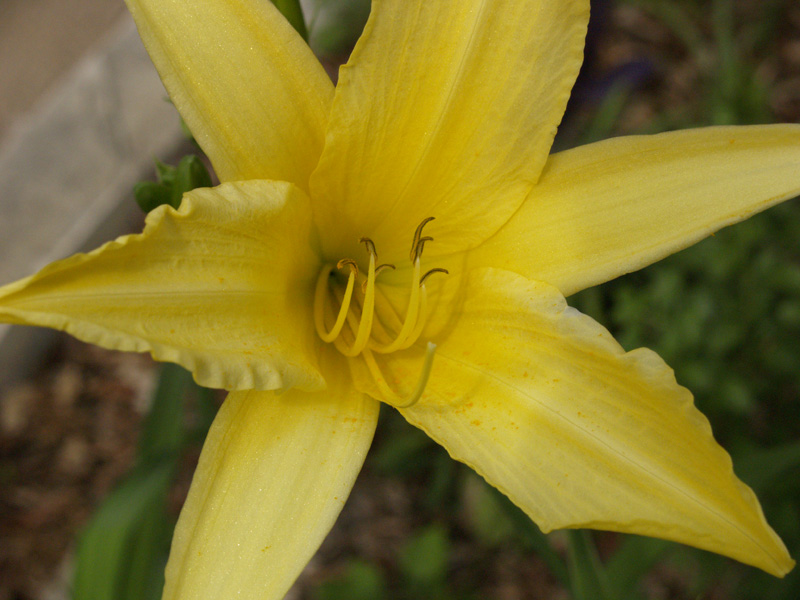April 21, 2011
Joys and Perils of Zone-Pushing
As gardeners, we tend to do a little zone-pushing, from ornamentals to vegetables (like playing weather Russian Roulette with early tomato planting). But no matter what comes our way, my evergreen, no-name daylilies from a little nursery years ago don’t get scared off.

On daylilies, go ahead and make a note right now for the Austin Daylily Society show & sale on May 21 from 1 to 5 p.m. at Zilker Botanical Garden.
Here are some of their beauties! This luscious one is “Scarlet Pansy.”


Freeze, drought, flood: my gold Spuria irises always flower in April after diligently pushing up foliage all winter.

My Peggy Martin climber is a true survivor, not just in my garden, but as one of two plants still alive in Mrs. Martin’s Louisiana garden after Hurricane Katrina.

Dr. William Welch took cuttings from his own roses to bring into propagation, and with each sale, to help restore destroyed Gulf Coast gardens and bring Peggy Martin to gardens like mine.
Next door to her resides my diligent Maggie, another Bill Welch Louisiana discovery.

By the way, with the hot-off-the-press new edition of his Heirloom Gardening in the South (A&M Press), Dr. Welch joins us on CTG this summer with some of his top survivors.

Since zone-pushing is especially on our minds these days, this week on CTG, Tom meets with Bill Scheick who came up with this week’s theme: The Joys and Perils of Zone-Pushing. Perhaps you’ve run into his passionate and informative garden articles as contributing editor of Texas Gardener magazine, his online book reviews for TG, and stories he’s shared with the Austin-American Statesman and others. Now, you can meet his wit and hands-on knowledge “in person!”
He explains how our zones are changing numbers per the Arbor Day Foundation’s latest map. Bill also explains how he pushes zones in his garden and how to do it. Get his list of zone-pushers and tips for plants like Golden thryallis (Galphemia gracilis).

Another Bill mentions is Pink jasmine (Jasminum polyanthum), a new Zone 9 favorite. Some people lost those this year in our unusual cold, but others carry on.

As he tells us, even a minor microclimate can make a difference. Zone-pushing includes location, established roots, and mulch.
My Star or Confederate jasmine (Trachelospermum jasminoides) is not a true jasmine, but scents the patio for months every spring. It got burned for the first time last winter and again this year, but after clipping its casualties, it barely delayed its dependable flowers. By happenstance, mine is trained like a shrub, but it’s known as an excellent evergreen screening vine, even in part sun.

Here it is with fragrant Marie Pavie rose in the background.

My ‘Mr. Mac’ Satsuma won’t be feeding me this year, thanks to the cold, but it fed a baby bird whose parent nabbed this swallowtail larva, despite its camouflage. Fortunately, another baby caterpillar or two is “on the way.” Swallowtails were all over the larkspur last night so let’s hope that after dinner they laid a few more eggs.

Since insects are on the breeding rampage right now, Trisha cautions us to recognize beneficial ones before we go on orange oil alert. Our featured guest on this segment is a ladybug larva scarfing up aphids. Trisha’s got tips for moving caterpillars around, trap crops for stink bugs, and simple organic tricks to spare valuable crops.
I think viewer Philip for his photographs to help us identify the nymph and adult stages of the very beneficial assassin bug. With all those red nymphs running around right now, take a second look to recognize this free “pesticide” in your garden, and make them welcome. Here’s Philip’s nymph assassin bug.

Here’s the adult.

Thanks to Wizzie Brown, entomologist for Texas AgriLife Extension, for more information about this beneficial insect.
Whew! This isn’t the hottest April I’ve ever known, but it’s pretty miserable. This week, Daphne answers Nancy Garrett’s great question on how to take care of our young tomato transplants with such onslaught. Get Daphne’s tips to avoid blossom-end rot, too, a common situation this time of year.
Her featured plant is one that you might still be seeing along the roadsides and fields, despite the lack of rain for wildflowers: Prairie verbena (Glandularia bipinnatifida).

When I was growing up, this was considered a detested weed in lawns. Lots more than weather changes have happened since then! Respect and encourage this tough survivor that feeds beneficial pollinators.
On tour, we repeat Master Gardener Randy Case’s garden. Even if zone-pushing changed his plant palette a bit, his essential design is what’s significant. Once we have our enduring patterns in place, we can adjust the plants as nature or our whimsy takes us.
Until next week, Linda
tags:

